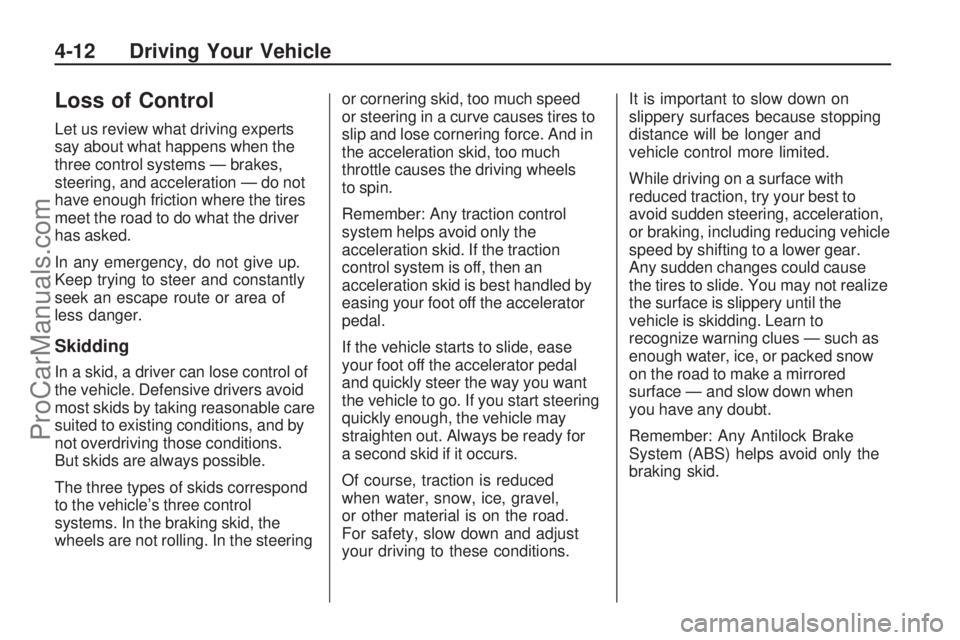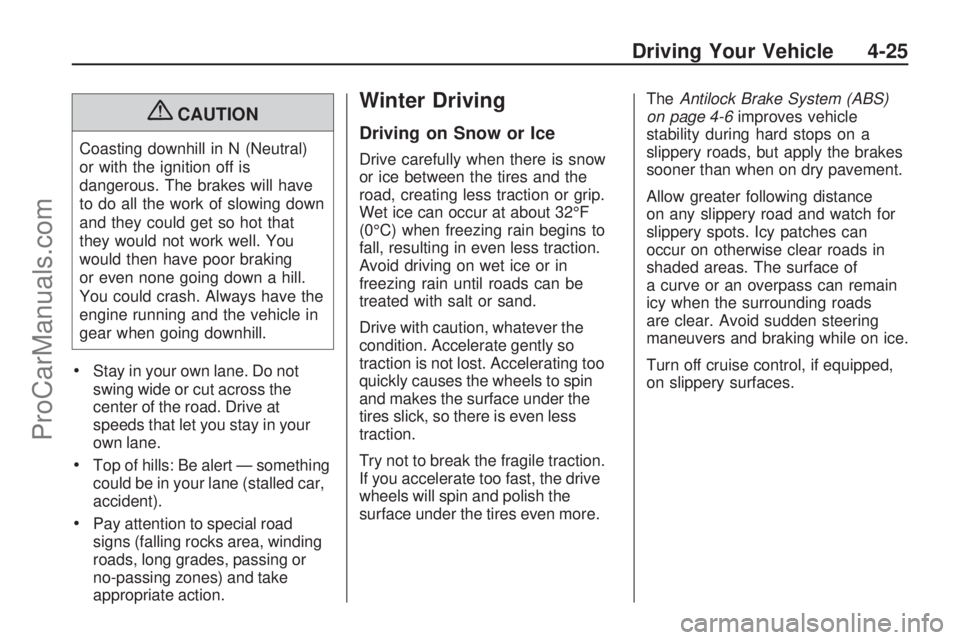ABS SATURN VUE 2009 User Guide
[x] Cancel search | Manufacturer: SATURN, Model Year: 2009, Model line: VUE, Model: SATURN VUE 2009Pages: 386, PDF Size: 2.3 MB
Page 216 of 386

Loss of Control
Let us review what driving experts
say about what happens when the
three control systems — brakes,
steering, and acceleration — do not
have enough friction where the tires
meet the road to do what the driver
has asked.
In any emergency, do not give up.
Keep trying to steer and constantly
seek an escape route or area of
less danger.
Skidding
In a skid, a driver can lose control of
the vehicle. Defensive drivers avoid
most skids by taking reasonable care
suited to existing conditions, and by
not overdriving those conditions.
But skids are always possible.
The three types of skids correspond
to the vehicle’s three control
systems. In the braking skid, the
wheels are not rolling. In the steeringor cornering skid, too much speed
or steering in a curve causes tires to
slip and lose cornering force. And in
the acceleration skid, too much
throttle causes the driving wheels
to spin.
Remember: Any traction control
system helps avoid only the
acceleration skid. If the traction
control system is off, then an
acceleration skid is best handled by
easing your foot off the accelerator
pedal.
If the vehicle starts to slide, ease
your foot off the accelerator pedal
and quickly steer the way you want
the vehicle to go. If you start steering
quickly enough, the vehicle may
straighten out. Always be ready for
a second skid if it occurs.
Of course, traction is reduced
when water, snow, ice, gravel,
or other material is on the road.
For safety, slow down and adjust
your driving to these conditions.It is important to slow down on
slippery surfaces because stopping
distance will be longer and
vehicle control more limited.
While driving on a surface with
reduced traction, try your best to
avoid sudden steering, acceleration,
or braking, including reducing vehicle
speed by shifting to a lower gear.
Any sudden changes could cause
the tires to slide. You may not realize
the surface is slippery until the
vehicle is skidding. Learn to
recognize warning clues — such as
enough water, ice, or packed snow
on the road to make a mirrored
surface — and slow down when
you have any doubt.
Remember: Any Antilock Brake
System (ABS) helps avoid only the
braking skid.
4-12 Driving Your Vehicle
ProCarManuals.com
Page 229 of 386

{CAUTION
Coasting downhill in N (Neutral)
or with the ignition off is
dangerous. The brakes will have
to do all the work of slowing down
and they could get so hot that
they would not work well. You
would then have poor braking
or even none going down a hill.
You could crash. Always have the
engine running and the vehicle in
gear when going downhill.
Stay in your own lane. Do not
swing wide or cut across the
center of the road. Drive at
speeds that let you stay in your
own lane.
Top of hills: Be alert — something
could be in your lane (stalled car,
accident).
Pay attention to special road
signs (falling rocks area, winding
roads, long grades, passing or
no-passing zones) and take
appropriate action.
Winter Driving
Driving on Snow or Ice
Drive carefully when there is snow
or ice between the tires and the
road, creating less traction or grip.
Wet ice can occur at about 32°F
(0°C) when freezing rain begins to
fall, resulting in even less traction.
Avoid driving on wet ice or in
freezing rain until roads can be
treated with salt or sand.
Drive with caution, whatever the
condition. Accelerate gently so
traction is not lost. Accelerating too
quickly causes the wheels to spin
and makes the surface under the
tires slick, so there is even less
traction.
Try not to break the fragile traction.
If you accelerate too fast, the drive
wheels will spin and polish the
surface under the tires even more.TheAntilock Brake System (ABS)
on page 4-6improves vehicle
stability during hard stops on a
slippery roads, but apply the brakes
sooner than when on dry pavement.
Allow greater following distance
on any slippery road and watch for
slippery spots. Icy patches can
occur on otherwise clear roads in
shaded areas. The surface of
a curve or an overpass can remain
icy when the surrounding roads
are clear. Avoid sudden steering
maneuvers and braking while on ice.
Turn off cruise control, if equipped,
on slippery surfaces.
Driving Your Vehicle 4-25
ProCarManuals.com
Page 247 of 386

Parking on Hills
{CAUTION
Parking the vehicle on a hill with
the trailer attached can be
dangerous. If something goes
wrong, the rig could start to move.
People can be injured, and both
the vehicle and the trailer can be
damaged. When possible, always
park the rig on a �at surface.
If parking the rig on a hill:
1. Press the brake pedal, but do
not shift into P (Park) yet.
Turn the wheels into the curb if
facing downhill or into traffic
if facing uphill.
2. Have someone place chocks
under the trailer wheels.3. When the wheel chocks are
in place, release the regular
brakes until the chocks absorb
the load.
4. Reapply the brake pedal. Then
apply the parking brake and
shift into P (Park).
5. Release the brake pedal.
Leaving After Parking on a Hill
1. Apply and hold the brake pedal
while you:
Start the engine
Shift into a gear
Release the parking brake
2. Let up on the brake pedal.
3. Drive slowly until the trailer is
clear of the chocks.
4. Stop and have someone pick up
and store the chocks.
Maintenance When Trailer
Towing
The vehicle needs service more
often when pulling a trailer. See
Scheduled Maintenance on page 6-3
for more information. Things that
are especially important in trailer
operation are automatic transmission
�uid, engine oil, axle lubricant, belts,
cooling system and brake system.
It is a good idea to inspect these
before and during the trip.
Check periodically to see that all
hitch nuts and bolts are tight.
Engine Cooling When Trailer
Towing
The cooling system may temporarily
overheat during severe operating
conditions. SeeEngine Overheating
on page 5-25.
Driving Your Vehicle 4-43
ProCarManuals.com
Page 321 of 386

Do not clean the vehicle using:
A knife or any other sharp object
to remove a soil from any interior
surface.
A stiff brush. It can cause damage
to the vehicle’s interior surfaces.
Heavy pressure or aggressive
rubbing with a cleaning cloth. Use
of heavy pressure can damage
the interior and does not improve
the effectiveness of soil removal.
Laundry detergents or
dishwashing soaps with
degreasers can leave residue
that streaks and attracts dirt. For
liquid cleaners, about 20 drops
per gallon (3.78 L) of water is a
good guide. Use only mild,
neutral-pH soaps.
Too much cleaner that saturates
the upholstery.
Organic solvents such as naptha,
alcohol, etc. that can damage the
vehicle’s interior.
Fabric/Carpet
Use a vacuum cleaner with a soft
brush attachment frequently to
remove dust and loose dirt. A
canister vacuum with a beater bar in
the nozzle may only be used on �oor
carpet and carpeted �oor mats. For
any soil, always try to remove it �rst
with plain water or club soda. Before
cleaning, gently remove as much of
the soil as possible using one of the
following techniques:
For liquids: gently blot the
remaining soil with a paper towel.
Allow the soil to absorb into the
paper towel until no more can be
removed.
For solid dry soils: remove as
much as possible and then
vacuum.
To clean:
1. Saturate a lint-free, clean white
cloth with water or club soda.
2. Wring the cloth to remove excess
moisture.3. Start on the outside edge of the
soil and gently rub toward the
center. Continue cleaning, using
a clean area of the cloth each
time it becomes soiled.
4. Continue to gently rub the soiled
area until the cleaning cloth
remains clean.
5. If the soil is not completely
removed, use a mild soap
solution and repeat the cleaning
process that was used with
plain water.
If any of the soil remains, a
commercial fabric cleaner or spot
lifter may be necessary. When a
commercial upholstery cleaner or
spot lifter is to be used, test a small
hidden area for colorfastness �rst.
If the locally cleaned area gives any
impression that a ring formation may
result, clean the entire surface.
After the cleaning process has been
completed, a paper towel can be
used to blot excess moisture from
the fabric or carpet.
Service and Appearance Care 5-73
ProCarManuals.com
Page 332 of 386

Fuses Usage
4WD/ESCMAll-Wheel Drive
System
ABSAntilock Brake
System Module
A/C CLTCHAir Conditioning
Compressor
BLWR MTR Blower Motor
AMP Ampli�er
HORN Horn
ABSAntilock Brake
System Module
I/P BECInstrument Panel
Bussed Electrical
CenterFuses Usage
FRT FOG Front Fog Lamps
I/P BECInstrument Panel
Bussed Electrical
Center
DRLDaytime Running
Light
T/LAMP RTRight Turn and
Parking Lamps
T/LAMP LTLeft Turn and
Parking Lamps
TRLR
T/LAMPTrailer Parking
Lamps
HDLPHILTPassenger Side
High-Beam
HeadlampFuses Usage
STOP LP Stoplamps
DEFOG Defroster Fog
HDLP
LO RTDriver Side
Low-Beam
Headlamp
HDLP
LO LTPassenger Side
Low-Beam
Headlamp
HDLP
HI RTDriver Side
High-Beam
Headlamp
OSRVM
HTROutside Rearview
Mirror Heating
5-84 Service and Appearance Care
ProCarManuals.com
Page 375 of 386

A
About Driving Your Vehicle......... ii
Accessories and
Modi�cations...................... 5-3
Accessory Power.................2-17
Accessory Power Outlets......3-16
Adding Equipment to Your
Airbag-Equipped Vehicle....1-57
Additional Required Services,
Scheduled Maintenance....... 6-6
Additives, Fuel...................... 5-6
Add-On Electrical
Equipment.......................5-79
Adjustment
Chime Level....................3-93
Air Cleaner/Filter, Engine.......5-17
Air Conditioning...................3-17
Air Filter, Passenger
Compartment...................3-24
Airbag
Readiness Light................3-29
Airbag System.....................1-42
Adding Equipment to
Your Airbag-Equipped
Vehicle........................1-57
How Does an Airbag
Restrain?.....................1-49Airbag System (cont.)
Passenger Sensing
System........................1-51
Servicing Your
Airbag-Equipped
Vehicle........................1-56
What Makes an Airbag
In�ate?........................1-49
What Will You See After
an Airbag In�ates?........1-50
When Should an Airbag
In�ate?........................1-47
Where Are the Airbags?.....1-45
Airbags
Passenger Status
Indicator.......................3-30
All-Wheel Drive....................5-35
All-Wheel Drive Disabled
Light...............................3-40
All-Wheel-Drive (AWD)
System............................. 4-9
Antenna
Fixed Mast......................3-93
Antenna, XM™ Satellite
Radio Antenna System......3-93
Antilock Brake
System (ABS).................... 4-6
Warning Light...................3-32Appearance Care
Aluminum Wheels.............5-77
Care of Safety Belts..........5-74
Chemical Paint Spotting.....5-78
Cleaning Exterior Lamps/
Lenses........................5-75
Fabric/Carpet...................5-73
Finish Care......................5-76
Finish Damage.................5-78
Instrument Panel, Vinyl,
and Other Plastic
Surfaces......................5-74
Interior Cleaning...............5-72
Leather...........................5-74
Sheet Metal Damage........5-78
Tires...............................5-77
Underbody Maintenance....5-78
Washing Your Vehicle........5-75
Weatherstrips...................5-75
Windshield and Wiper
Blades.........................5-76
Assistance Program,
Roadside.......................... 7-6
Audio System......................3-64
Audio Steering Wheel
Controls.......................3-92
Navigation/Radio System,
see Navigation Manual . . . 3-81
INDEX i-1
ProCarManuals.com
Page 380 of 386

Highway Hypnosis................4-24
Hill and Mountain Roads.......4-24
Hood
Checking Things Under.....5-10
Release..........................5-11
Horn .................................... 3-5
How to Wear Safety Belts
Properly..........................1-14
I
Ignition Positions..................2-16
Infants and Young Children,
Restraints........................1-26
In�ation - Tire Pressure.........5-49
Instrument Panel
Brightness.......................3-14
Cluster............................3-27
Overview........................... 3-4
Storage Area....................2-42
Introduction........................... 6-1
J
Jump Starting......................5-31
K
Keyless Entry, Remote
Operation.......................... 2-4
Keyless Entry System............ 2-3
Keys.................................... 2-2
L
Labeling, Tire Sidewall..........5-44
Lamp
Malfunction Indicator.........3-35
Lamps
Daytime Running (DRL).....3-13
Dome .............................3-14
Front Turn Signal and
Parking Lamps..............5-40
License Plate...................5-41
Reading..........................3-15
Lap-Shoulder Belt................1-19
LATCH System for Child
Restraints........................1-31
Liftgate
Carbon Monoxide............... 2-9
Lighting
Entry..............................3-14Lights
Airbag Readiness.............3-29
All-Wheel Drive Disabled....3-40
Antilock Brake System
(ABS) Warning..............3-32
Brake System Warning......3-31
Change Engine Oil...........3-38
Charging System..............3-31
Cruise Control..................3-38
Daytime Running Lamps
Indicator.......................3-39
Door Ajar.........................3-40
Engine Coolant
Temperature Warning.....3-34
Exterior Lamps.................3-12
Flash-to-Pass..................... 3-7
Fog Lamp ........................3-38
Gate Ajar.........................3-40
Highbeam On...................3-39
High/Low Beam Changer..... 3-7
Low Fuel Warning.............3-41
Low Washer Fluid
Warning.......................3-40
Oil Pressure.....................3-37
Passenger Airbag Status
Indicator.......................3-30
i-6 INDEX
ProCarManuals.com